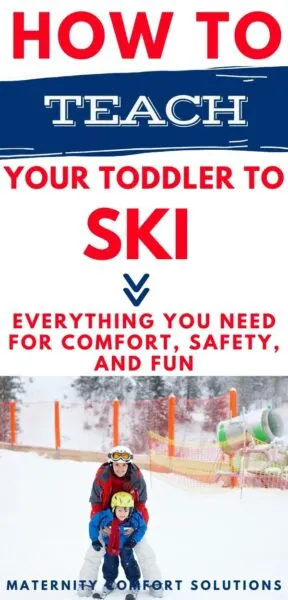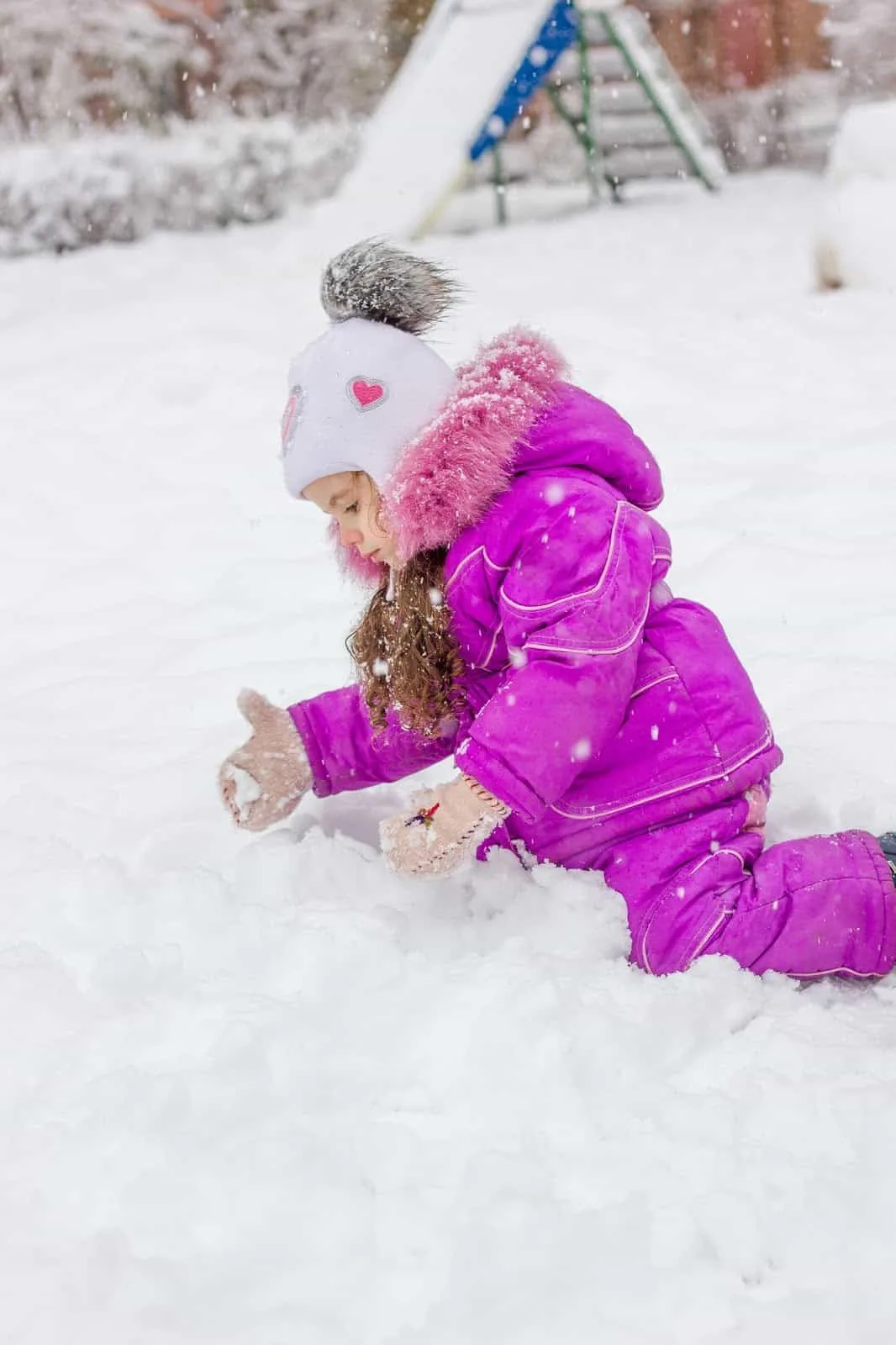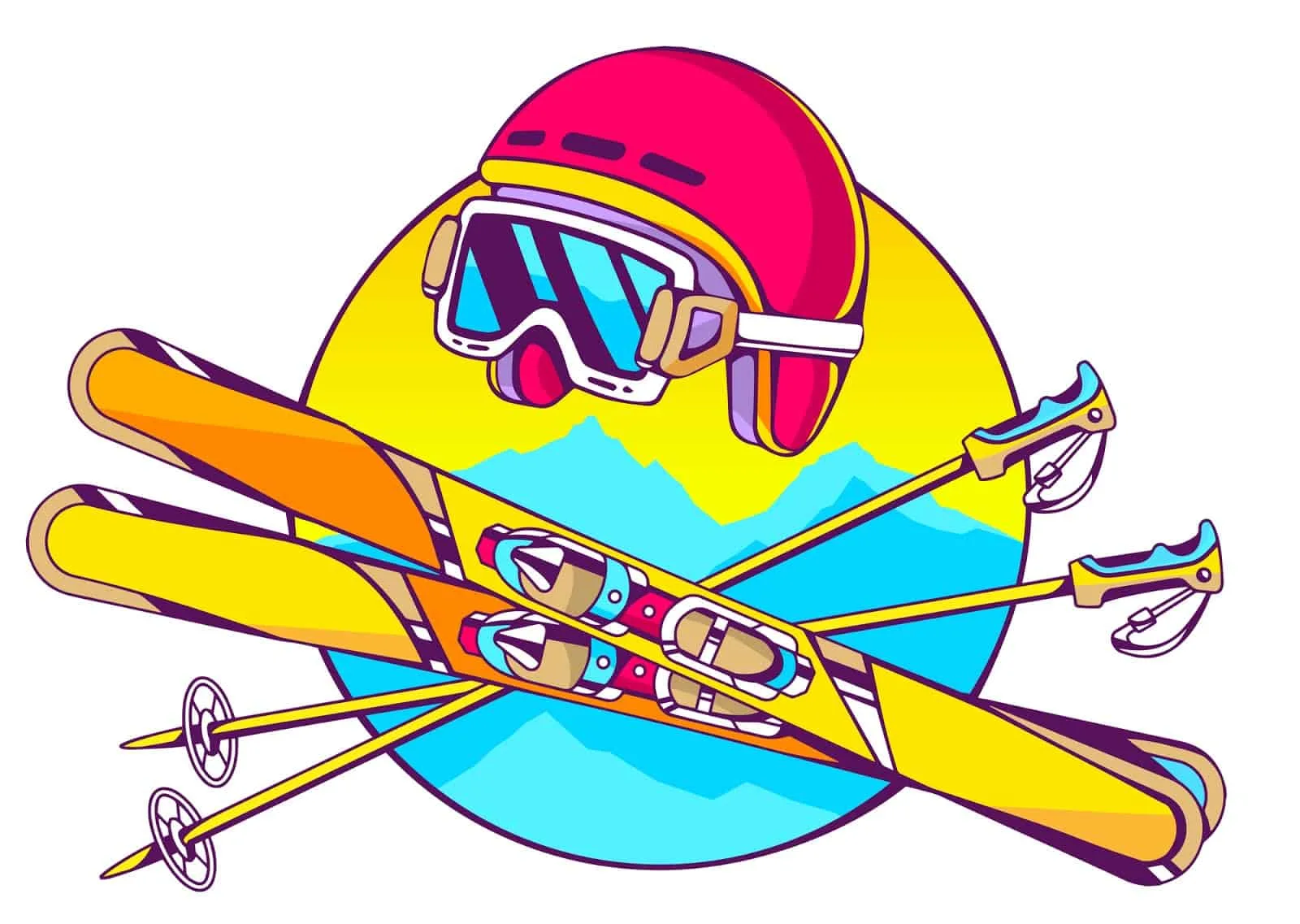Updated December 26, 2022
Are you wondering if your toddler is old enough to learn how to ski? The answer is Yes! Plus, teaching your toddler to ski offers many developmental benefits.
Skiing can have a positive impact on her physical and emotional development. It is an excellent form of exercise and instills confidence. Learning to ski helps your toddler develop her gross motor skills, problem-solving ability, and love of the outdoors.
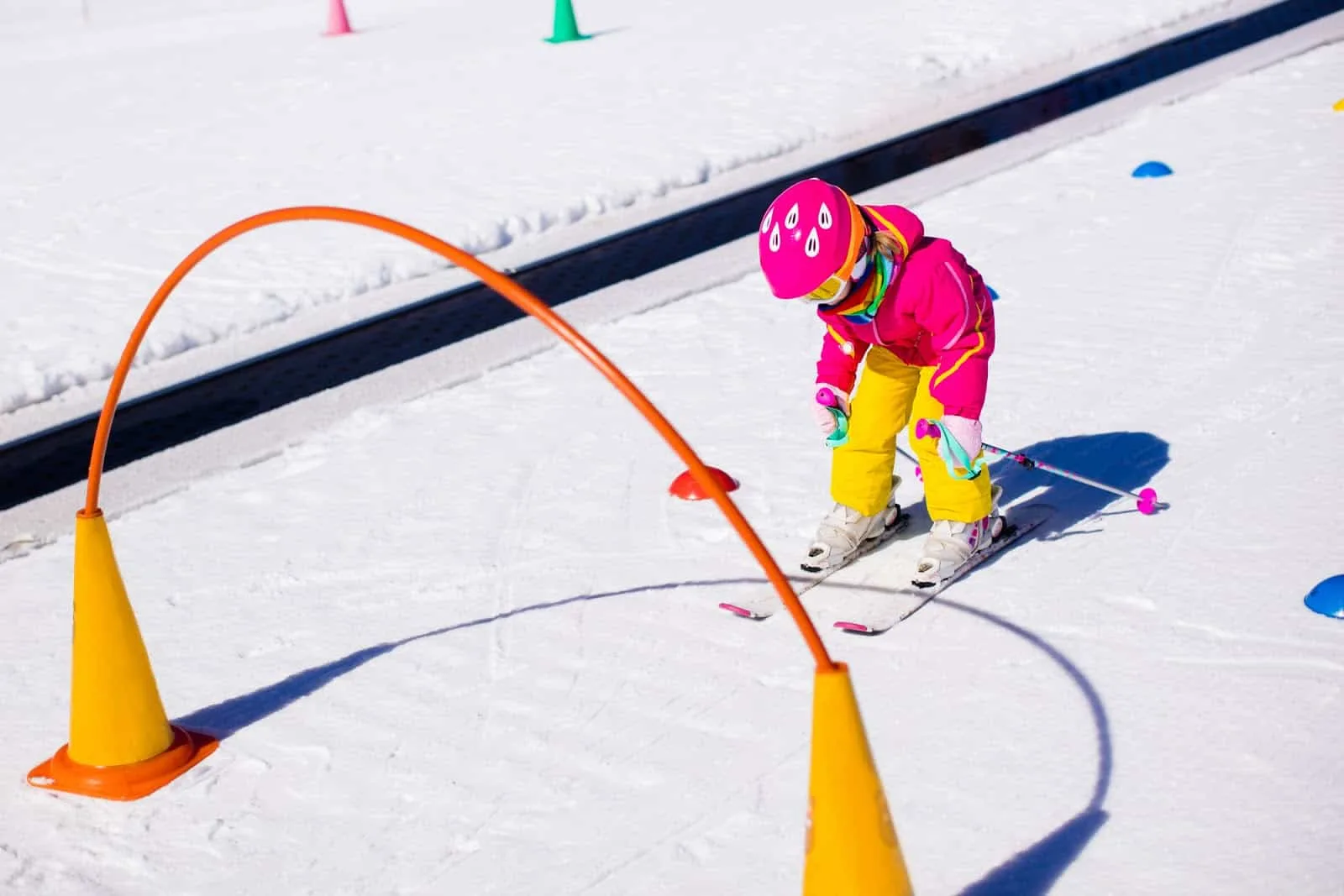
In addition, skiing is a great activity to bring families together.
Families who ski together, spend time together
If you teach your 2-year-old to ski, the day will come when you will have a teenager who will be grateful they were put on skis at such a young age.

Teaching your toddler to ski
When it comes to skiing, your toddler will either love it or hate it.
Toddlers like to ski because it is fun, if your 2-year-old does not like skiing, let it go.
Pushing your child to take up skiing can backfire very easily. Trying to reason with a cold and overtired 2-year-old rarely turns out well.
If your child likes skiing, it may become a lifetime passion.
Children who learn to ski as soon as they can walk, often go on to ski competitively in middle school, high school and beyond.
Skiing is a sport that is far more difficult to pick up later in life.
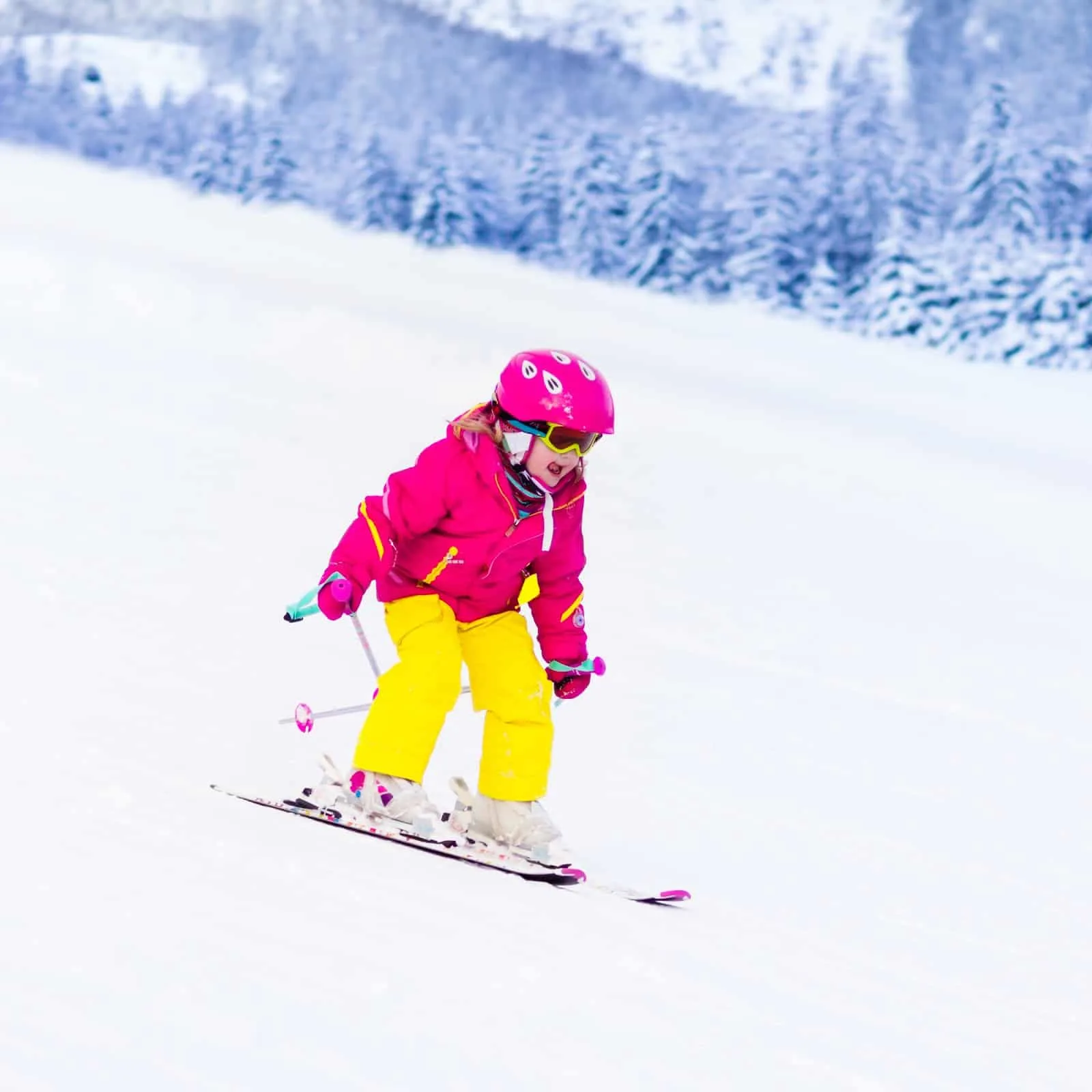
Who hasn’t seen a fearless toddler racing down the slope?
If you want to give your child the best opportunity to become an expert skier get her on skis as soon as possible. Skiing is all about having fun for a toddler. Learning the mechanics of skiing comes later.
Why it is important to get your toddler on skis:
1. Toddlers Have NO FEAR.
Toddlers have no fear because they don’t know what to fear.
When learning to ski this is a gift but it also means your toddler will need close supervision at all times to prevent injury.
2. Toddlers Are Less Prone To Injury.
Skiing can be a dangerous sport for anyone at any age. Toddlers are less likely to get injured when they fall for a number of reasons:
- Low center of gravity.
- No fear means their body is more relaxed.
- Parents make sure they wear the proper safety equipment.
- As we get older, our bodies are more susceptible to musculoskeletal injuries.
- Toddlers learn to ski without poles.
Staying in control is the most important way to prevent injury. Fortunately, helmets have become a standard piece of ski equipment for toddlers.
Tips to remember when teaching a toddler to ski:
- Supervision by a parent who knows how to ski or a qualified professional skier is essential at all times.
- Proper safety equipment is a must and doesn’t have to be new. A used helmet works just as well as a new one.
- If your child wants to learn how to “ski”, lessons by a certified instructor are a must. (If your child does not like to ski, that’s alright, never force the issue. Problems arise when children do not feel free to share their likes and dislikes.)
3. Your toddler has the time to learn. Put it to good use.
It is not long before your 2-year-old will be barraged with activities, from playdates to scheduled events and school projects.
If you really want your toddler to learn to ski, you don’t want to miss this window of opportunity.
Two-year-olds are fearless and determined. Give them the opportunity and guidance and it is amazing what they can do.
4. Toddlers learn fast. Take advantage of this while you can.
When given an age-appropriate task, toddlers learn fast compared to adults.
Every day, your child is learning new sensory and motor skills (Sight, Sound, Touch, Smell, Taste).
They learn how to integrate these skills to perform more complex tasks.
Their minds are constantly developing physically and emotionally.
Young children are not distracted by the stress and hangups that can interfere with our ability to think clearly.
They live in the present, not yet hampered by thoughts about the past and plans for the future.
Toddlers are focused and determined to complete a task.
If you interrupt a toddler working on an activity, be ready for a tantrum that will leave you feeling like the worst parent in the world.
Toddlers want what they want when they want it and why wouldn’t they?
When it comes to learning how to ski, a toddler’s determination is a good thing, as long as it is kept under control.
The secret is to learn how to channel your little one’s energy to achieve positive results and instill self-confidence.
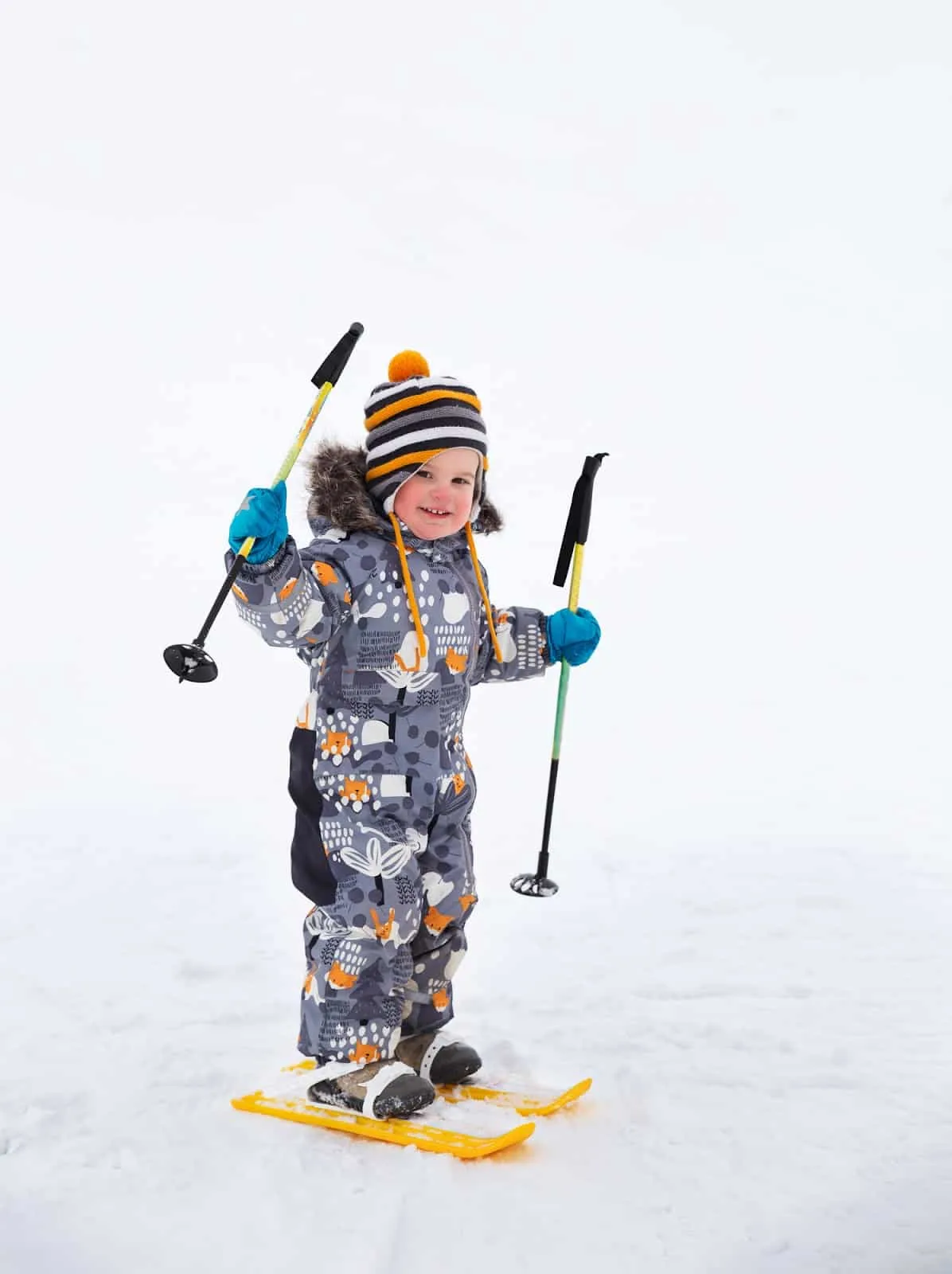
If you are a parent and have made it this far, you are probably serious about teaching your toddler to ski.
So far we have focused on why you may want to get your child on skies at a very early age.
Now let’s jump in and talk about how you can help your toddler have positive early skiing experiences.
There are three BIG things that determine whether or not a toddler will enjoy skiing:
1. Is your toddler comfortable?
It is essential you dress your toddler appropriately for skiing. You want her to remain warm and dry. Dress your child in a warm snowsuit, hat, gloves, and boots.
Toddlers won’t forget if their first exposure to a winter sport is unpleasant.
If your child is resisting, for whatever reason (too cold, too tired) call it a day.
You can’t reason with a cold toddler, crying to go into the house.
Do whatever is necessary to avoid making this winter activity a deal-breaker from the get-go.
2. Is your toddler safe?
Staying safe on the slopes is important. Skiing can be a dangerous sport.
Tips to make skiing safer for your toddler:
- Wear A Helmet – Your child must always wear a helmet. Head injuries are drastically reduced by protective headgear.
- Avoid Extremely Cold Weather – Aside from the risk of frostbite, there is little doubt your toddler will have a miserable time.
- Choose The Right Ski Slope – Chose wide-open slopes that are easy to navigate and free of trees, rocks or other stationary objects.
- Check Ski Conditions – Icy conditions cause more injuries. Learning to ski in icy conditions is practically impossible. Avoid heavy powder as well. The best snow is packed powder.
3. Is your toddler having fun?
Learning a new activity that requires lessons and discipline can be stressful. The idea that skiing is fun is not readily apparent given all the preparation that is necessary.
This is especially true for toddlers.
For those who ski, it is not hard to relate to the significant amount of preparation that is required before ever getting on the slope.
For a 2-year-old, doing something for some future benefit is far beyond their level of understanding.
Bring snacks and hot chocolate and be as prepared as possible when first introducing a toddler to skiing.
Once toddlers understand how much fun it is, the next ski trip will be easier since they can anticipate what is coming.
What Ski Gear Do You Need For Toddlers?
1. Helmet:
A ski helmet is the most important piece of ski gear you will buy for your child. You will want to be sure to select a CPSC ASTM-certified helmet that fits properly.
Helmets help prevent serious head injuries should your child fall, collide with another skier, or hit a stationary object (tree, rock, or ski lift tower).
Retrospec Traverse H3 Youth Ski & Snowboard Helmet
2. Harness:
When your child is just starting to ski, a ski harness can keep your child’s speed under control until he/she learns how to stop and turn.
Launch Pad Ski and Snowboard Training Harness
NOTE: There are additional benefits and some drawbacks to using a harness which will be discussed below.
3. Edgie Wedgie:
An Edgie Wedgie helps your child maintain control in the snowplow ski position (see below).
3. Skis (No Poles), Ski Boots, and Bindings:
Buying skis for a toddler runs the full spectrum when it comes to cost. When purchasing skis, bindings, and boots (below) the most important factor to keep in mind is safety.
Safe ski gear, is sized correctly, fits well, and is adjusted to release properly to avoid injury.
4. Winter Clothing:
It is critical for your child to have the appropriate winter clothing to stay warm and dry.
The items listed below should be designed for skiing (fit well and have no loose ends):
- Coat
- Ski pants
- Sweater
- Thermal underwear
- Thermal socks
- Facemask
- Hat
- Gloves
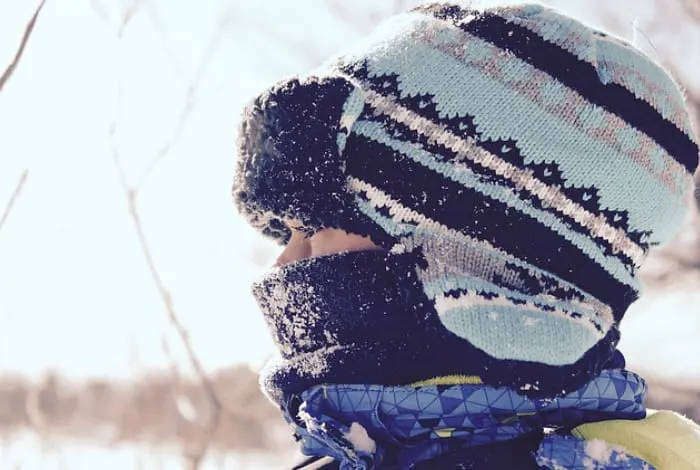
If you select the correct winter clothing your child will end the day on a good note.
You want your child’s initial experience to be a positive one.
Warm gloves are an absolute must to prevent frostbite which can happen quickly.
Toddlers are caught up in the moment, so you can’t rely on your child to tell you their hands are cold.
5. Sunscreen:
Sunscreen is no less important than when you take your child to the beach.
The cold weather can mask a sunburn until the end of the day when you are peeling off the clothing.
Use a high-SPF sunscreen. Also, if you choose to ski on a cold day or when there is a significant wind chill, your child should wear a mask.
The cheeks can get blotches of frostbite very quickly.
6. Goggles:
Ski goggles have filters to help your child see clearly in good or bad weather.
Goggles are an essential piece of ski gear to help prevent your child from hitting rocks, other skiers and worst of all stationary objects such as trees and ski lift towers.
(I have seen this happen to toddlers on more than one occasion).
Goggles also offer eye protection from flying debris and can help to prevent an eye injury if a collision occurs.
Where to buy toddler ski gear?
Ski gear can be expensive. However, the cost to get your 2-year-old fitted with proper ski gear does not have to break the bank.
There are many places to find inexpensive, second-hand ski gear for children. The following are some of the places we have purchased ski gear for our kids.
There’s no reason to spend a small fortune on ski gear that will last only one season.
In fact, purchasing higher quality, second-hand ski equipment can be a safer option.
- Second-hand stores: Stores that focus on sporting gear (ie. Play It Again Sports).
- Garage Sales: Garage sales can be a great place to buy second-hand ski equipment depending on where you live. If you live in “Ski Country” you will be more likely to find ski gear at yard sales. Prices at yard sales are almost always the most reasonable.
- Ski swaps: Ski swaps are often sponsored by schools, churches, and youth groups. Kids grow out of sporting equipment fast so it is not hard to find most items (listed below) for a fraction of the price or for free if you have items to swap. Young children grow out of sporting equipment very quickly (lasting only one season). There will always be those who will have the new and latest equipment. Best of all, this is the same equipment you will be getting at a fraction of the price. A used helmet works just as well as a new one and far better than no helmet at all.
If you purchase second-hand skis, it is a must to have them professionally serviced so the skis are safely adjusted based on your child’s weight and skiing ability (beginner).
How to get your toddler to feel comfortable wearing ski gear:
Create Indoor Skiing Games:
Toddlers love games. So why not make up some very simple indoor games? Games can be a great way to help your toddler get used to wearing ski boots and skis.
The tasks can be as simple as kicking a ball with skis. Teach the names of all the ski gear and what each item is used for.
Encourage your toddler to play with and try on their ski gear so they can get used to how heavy it feels.
Toddlers are often not most coordinated, to begin with, so let them know that falling and struggling is normal (even for mom and dad!).
Go to a ski resort that caters to kids
These resorts are small and focus on ski gear comfort, ski activities, beginner slopes, and ski lifts that cater to the needs of very young children.
For parents who are expert skiers, teaching their toddlers how to ski can still be challenging. It is important to remember what it felt like when you first started skiing and start out very slowly.
Even adults can get overwhelmed when trying to tackle a new venture, this can cause anxiety and ultimately lead to discouragement and disinterest.
By starting out very slow, your toddler will feel in control and you will know when he or she is ready to go to the next step.
If you push too hard, frustration can lead to tears and tantrums and when you add in the cold weather, you will likely be fighting a losing battle trying to keep your child on the ski slope.
If this occurs stop, go inside, have some hot chocolate and try again another day.
When should your toddler hit the ski slopes and take ski lessons?
Deciding when your toddler is ready to go to a ski resort and start ski lessons is a decision only a parent can make.
For parents who do not ski, this decision is best made with the help of a professional skier or ski instructor.
It is extremely important that your child learns the fundamentals correctly from day one. This is a matter of safety.
A skier (at any age) must know how to turn and stop before tackling the slopes.
Why are ski lessons so important for toddlers?
Stopping and turning are two basic skills any skier must know to reduce the possibility of a serious injury.
Many sports can be self-taught because there is no significant risk of injury.
Skiing is definitely not one of them!
Knowing how to stop and turn is how a beginner is able to remain in control at all times.
Skiing out of control is no different than driving a car without brakes.
This is not a pleasant thought but it is the truth and serious injuries can result if your toddler loses control.
Once your toddler puts on skis, one-on-one, undistracted supervision is a must at all times.
Teaching Your Toddler To Ski Before Hitting The Slopes
In a beginner ski school class, instructors will go through the basic information all skiers need to know to avoid danger and potential injury.
This information involves ski terms and signage. Even though toddlers cannot read, the terms are associated with the signs. This information is primarily focused on skiing ability (Beginner, Intermediate, Expert) and slope difficulty (Easy: Green Dot, Intermediate: Blue Square, and Expert: Black Diamond).
At any age, a skier must feel confident and there is no shortcut to reaching this goal. Becoming a confident skier requires proper instruction and practice.
If a skier lacks confidence, fear will be the emotion that will prevail.
However, the problem with toddlers is that they do not fear anything. Toddlers learn what to fear through experience and parental guidance.
Teaching Your Toddler How To Ski
Up until now, we have been discussing how to prepare your toddler for the ski slope. Now it is time to discuss how to teach a 2-year-old to ski.
The most popular methods include the use of a Harness and an Edgie Wedgie.
Using a Harness is helpful when your toddler is just starting to ski. We all know how quickly toddlers can get away on foot.
On skis, they can slip away much faster and this can result in a serious injury.
The harness is not only used for control. It can also help your child learn to turn and has a handle to assist your child when getting on a ski lift.
Though the ski harness can be helpful, it also has some drawbacks. It should be used for a limited time so your child does not become dependent on it. The weight distribution is very different when a child is wearing a harness.
The Edgie Wedgie helps your child keep his/her skies in the snowplow position (see below).
Maintaining this position can be challenging for a toddler because it requires leg strength. With this device, your child will also learn muscle memory.
Learning to Snowplow:
The snowplow is the most basic skiing position and is used by anyone of any age. The snowplow is not only used when learning to ski.
It is the universal skiing technique any skier can use to maintain control. Even expert skiers will resort to the snowplow to gain control if necessary.
Ski Patrol uses the snowplow to maintain control when transporting skiers down the slope.
Once your child has mastered the snowplow “the rest is history” as they say! Your child will be able to control his or her speed and will be able to stop and turn.
Time on skis, practice, and lessons will allow your child to advance
Why is the “snowplow” skiing technique so important?
- It is used to stop
- Controls speed
- Teaches skiers to turn
- Prevents fear once the skier knows how to stop
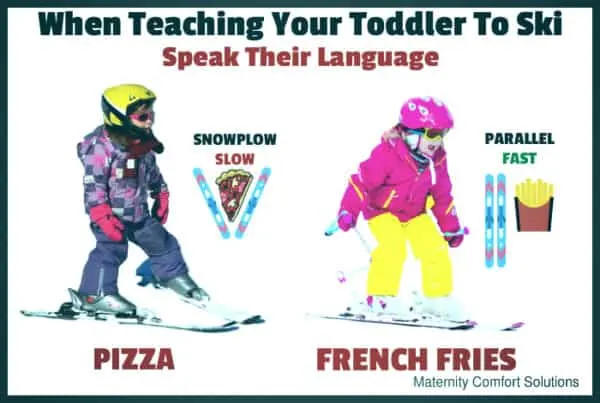
Once your child is able to snowplow and maintain balance and control, the next step will be to go on a beginner’s slope.
If you are a parent that can ski well, you can start to slowly ski backward with your child in front of you between your skis.
From this point on, teaching your toddler to ski comes down to how much time and effort you want to devote to this activity.
Ultimately, if your child loves to ski, the more time your child spends on skis the better he or she will become.
Teaching your toddler to ski can be challenging (even if you are an expert skier).
Take it slow and make it fun.
Skiing is a sport your family can enjoy together. You want your toddler’s first ski experiences to be positive.
Dress your toddler for skiing, make sure they wear a properly fitted helmet, and supervise them at all times.
Keep the sessions short, praise their effort, and do something fun together when you come in from the slopes.
When it comes to teaching your toddler to ski, “Having Fun Is Number One”. We all know that toddlers are impatient and have a very short attention span.
Immediate gratification is the name of the game when it comes to teaching your toddler to ski.
As parents who have taught our children to ski (and lived to tell the tale), the most important thing for you to have is an abundance of patience, a sense of humor, and a love of hot cocoa that doesn’t hurt either.
If you have any questions about teaching your toddler to ski, don’t hesitate to reach out to a children’s ski instructor.

